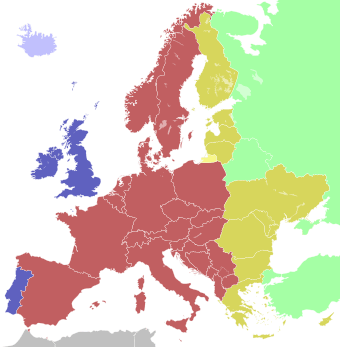Time in Germany facts for kids

Time zones of Europe in relation to UTC:
Light colours indicate countries that do not observe summer time.
| blue | Western European Time (UTC+0) Western European Summer Time (UTC+1) |
| light blue | Western European Time (UTC+0) |
| red | Central European Time (UTC+1) Central European Summer Time (UTC+2) |
| yellow | Eastern European Time (UTC+2) Eastern European Summer Time (UTC+3) |
| orange | Kaliningrad Time (UTC+3) |
| green | Further-eastern European Time (UTC+3), a.k.a. Moscow Time |
The time zone in Germany uses Central European Time (Mitteleuropäische Zeit, MEZ; UTC+01:00) and Central European Summer Time (Mitteleuropäische Sommerzeit, MESZ; UTC+02:00). Daylight saving time (DST) is observed from the last Sunday in March (02:00 CET) to the last Sunday in October (03:00 CEST).

All content from Kiddle encyclopedia articles (including the article images and facts) can be freely used under Attribution-ShareAlike license, unless stated otherwise. Cite this article:
Time in Germany Facts for Kids. Kiddle Encyclopedia.